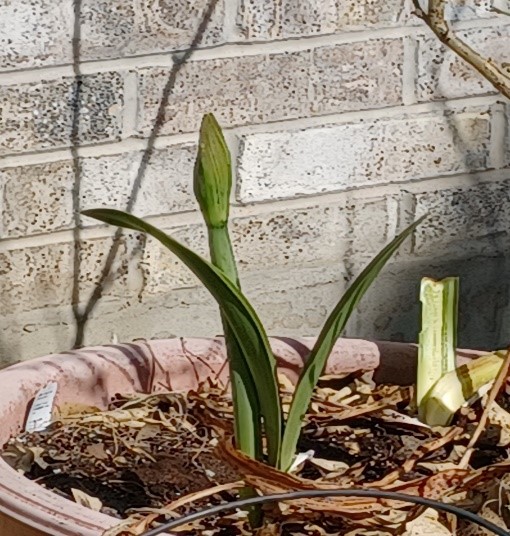by Mary Cennamo, Bexar County Master Gardener
The Amaryllis (Hippeastrum) is a tropical plant that originated in regions of South America and Africa. The genus Amaryllis comes from the Greek word amarysso, which means “to sparkle” and, indeed, Amaryllis are gorgeous, showy flowers.

House Plant or in The Garden?
The Amaryllis plant is usually a house plant, and often is received as a gift during the winter holiday season. Many of us just throw the bulb into our compost bin if you have one, or out into our garbage after the holidays are over. But resist the urge! These plants can remain flowering every year in your home for 40 years or more as a houseplant or in the ground in your garden if you take care of it properly.
My husband purchases an Amaryllis plant every year for me at Christmas along with a poinsettia or two. Once the Amaryllis finishes its bloom indoors, I put the bulb right into my garden after the last frost, typically around March 12th. You should leave the top inch or 1/3 of the bulb above the soil level for best flowering.
These plants take a little more care when they are out in our gardens compared to the plants that we buy at the store, but it’s worth it to enjoy the beauty of this flower outside in your garden.

Surviving the Freeze
As a tropical plant, the Amaryllis is sensitive to prolonged freezes that we have grown accustomed to north of San Antonio during the wintertime. Similar to most tropical plants, they will die if they are outside in your garden in the wintertime during a freeze without any protection. Even so, I have found that the Amaryllis in my garden survived the great freeze of 2021 in San Antonio without even a warming blanket or milk bottle greenhouse. All they had was the mulch that I had given them during the growing season.
Caring For Your Amaryllis
The Amaryllis bulb is hardy in Zone 8 (San Antonio) and your bulbs can be planted outside into your garden after the last freeze in the middle of March. I compost and fertilize with a slow-release fertilizer (10,10,10) initially in the spring and twice more during the year. I then mulch the bulbs (two inches) when the soil temperature gets warmer, usually in the beginning of May.
The mulch acts as a temperature regulator and a barrier for keeping in the moisture so the soil remains moist for a longer period of time. With proper mulching, you will use less water during the growing season. The soil’s temperature doesn’t fluctuate with the extreme cold or heat that we have in San Antonio, another added benefit. I have placed the plants in my garden on the south side of my home, so they get the morning sun through 3:00 o’clock but don’t suffer through the scorching afternoon sunshine that is so stressful for our plants during the hot summer months.

What Do you Do After your Amaryllis Blooms?
After your Amaryllis blooms and the flowers begin to fade it’s a great time to cut the hollow flower stalk back to about 2 inches above the bulb. Leave the leaves on the plant because that’s where the energy is produced for the next year’s flower bloom; the energy is stored in the bulb. If you leave the spent flowers on any plant, the plant tends to put its energy into making seed instead of storing its energy in its bulb for the next year’s flower bloom.
You can propagate Amaryllis with the seeds that are produced but it takes 2 to 3 years to get a mature plant to flower from a seed. Usually, the propagated Amaryllis is not the same color as the parent. With some annuals like sunflowers, cosmos, bluebonnets to name a few, you want the plant to go to seed to either collect them or just let the seeds fall where they may for next year’s crop of flowers, but not with the Amaryllis plant.
Two years ago, I was running out of room in my flowerbed so I put 2 new Amaryllis bulbs from Christmas in the big pot that my lime tree is in. I then moved the lime tree to the garage for winter protection as I do every year and I found that it’s good for Amaryllis bulbs to be dormant in the wintertime with no water or light for up to 8 to 10 weeks in my garage; in fact, one had a pretty tall flower stalk already when I took them out of the garage last weekend. It was a pleasant surprise!
I plan on putting other Amaryllis in that big pot this year to see how they perform. The Amaryllis in my outside garden bloom around Easter time; mine are still growing the flower stalk at this moment. The ones that I bought around Christmas time and put in the garden are blooming right now.
Photo credit: All photos by the author.
